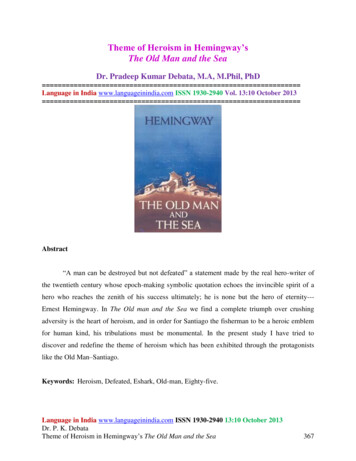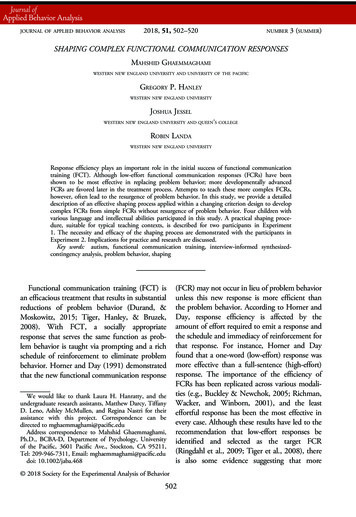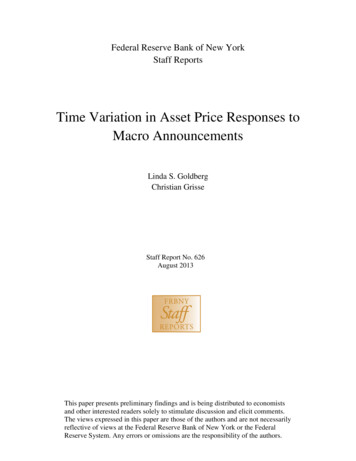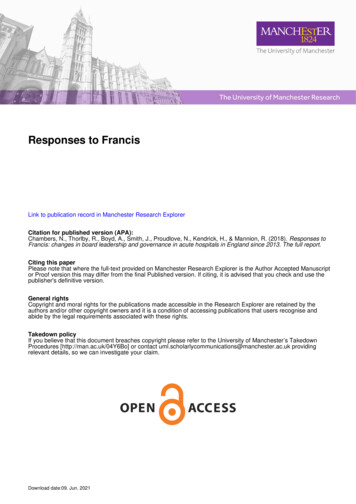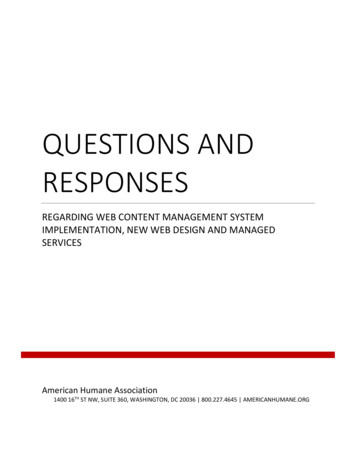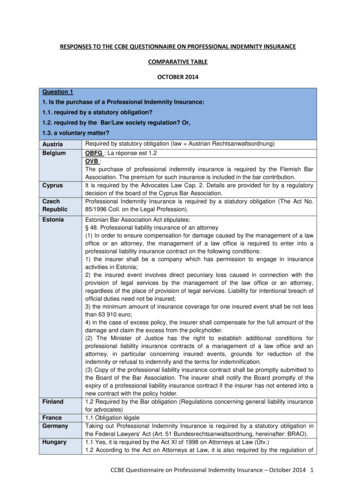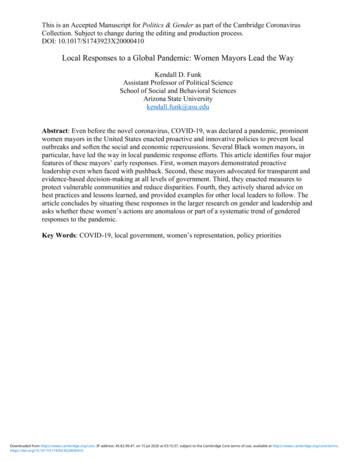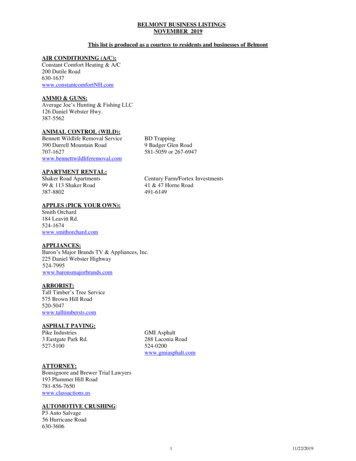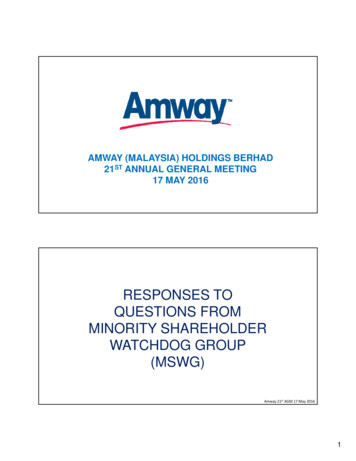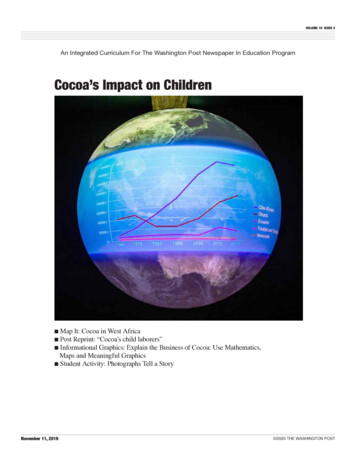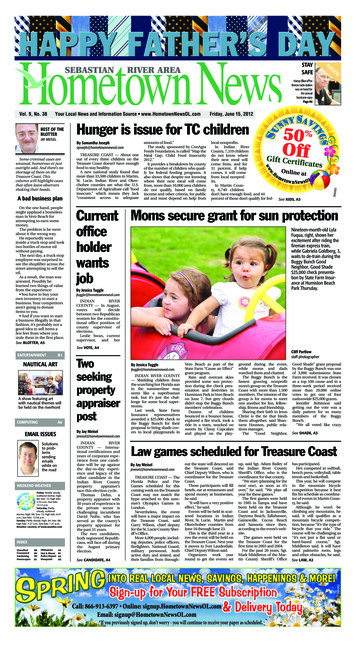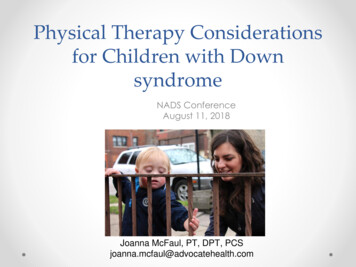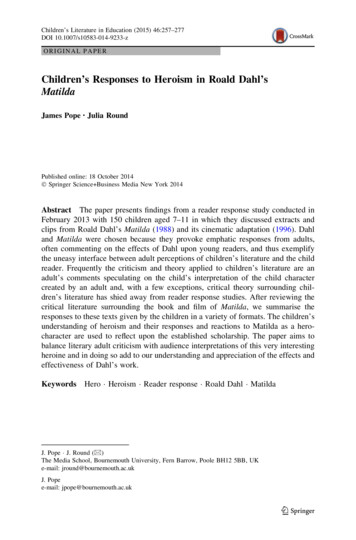
Transcription
Children’s Literature in Education (2015) 46:257–277DOI 10.1007/s10583-014-9233-zORIGINAL PAPERChildren’s Responses to Heroism in Roald Dahl’sMatildaJames Pope Julia RoundPublished online: 18 October 2014 Springer Science Business Media New York 2014Abstract The paper presents findings from a reader response study conducted inFebruary 2013 with 150 children aged 7–11 in which they discussed extracts andclips from Roald Dahl’s Matilda (1988) and its cinematic adaptation (1996). Dahland Matilda were chosen because they provoke emphatic responses from adults,often commenting on the effects of Dahl upon young readers, and thus exemplifythe uneasy interface between adult perceptions of children’s literature and the childreader. Frequently the criticism and theory applied to children’s literature are anadult’s comments speculating on the child’s interpretation of the child charactercreated by an adult and, with a few exceptions, critical theory surrounding children’s literature has shied away from reader response studies. After reviewing thecritical literature surrounding the book and film of Matilda, we summarise theresponses to these texts given by the children in a variety of formats. The children’sunderstanding of heroism and their responses and reactions to Matilda as a herocharacter are used to reflect upon the established scholarship. The paper aims tobalance literary adult criticism with audience interpretations of this very interestingheroine and in doing so add to our understanding and appreciation of the effects andeffectiveness of Dahl’s work.KeywordsHero Heroism Reader response Roald Dahl MatildaJ. Pope J. Round (&)The Media School, Bournemouth University, Fern Barrow, Poole BH12 5BB, UKe-mail: jround@bournemouth.ac.ukJ. Popee-mail: jpope@bournemouth.ac.uk123
258Children’s Literature in Education (2015) 46:257–277IntroductionDepictions of the child in literature for children are often polarised anddichotomous: for every Horrid Henry there is a Perfect Peter. Roald Dahl is afascinating author in that his books for children feature child heroes who are veryoften neither hero nor villain, but a wild, subversive combination of both. Wild,because they are endowed with powers or allies that enable them to take lawlessrevenge upon abusive or disliked adults: for example, think of George’s triumphover his hideous Grandma. Subversive because, as many critics (Worthington, 2012;Petzold, 1992; Christine Wilkie-Stibbs, 1996) note, Dahl’s stories are often fairytales in which the usual cautionary functions are abandoned, empowering the childto radically challenge and even reject the adult world rather than conform. Examplesinclude Revolting Rhymes, whose Little Red Riding Hood shoots her wolf herself,and James and the Giant Peach, where James effectively has his nasty aunts killedand escapes the ‘real’ world of oppression for a fantasy world of freedom. Dahl’schild heroes and heroines are not helpless victims awaiting rescue by prince orwoodcutter: rather they can be, when provoked, avengers who walk energeticallyoff the beaten track, go looking for their threatening giants and wicked step-parentsand retaliate aggressively against maltreatment, not relying upon adults or the ruleof law.This paper discusses a child character who has been viewed as both good andbad; both heroine and wrong-doer: Matilda, from Dahl’s 1988 novel of that name.Matilda is a super-intelligent child (aged 5 in Dahl’s book and 6 in the 1996movie) who is ridiculed and mistreated by her ignorant parents, then terrorised byher headmistress, Miss Trunchbull. She is the archetypal oppressed child hero of thefairy tale, ‘isolated, but with the capacity of universal relationships’ (Petzold, 1992,p. 186). But, as her mistreatment by adults puts her under increasing pressure shebegins to punish her parents, and later develops supernatural powers which enableher to take revenge upon Miss Trunchbull. The successful film (De Vito, 1996)recreates the final dismissal of Trunchbull as an even more humiliating punishment,in which all the school children join in Matilda’s fight, forcing Trunchbull to runfrom a tsunami of thrown missiles. However humorously delivered, there is avindictive spirit at work in both book and film.There is a great deal of tension within Matilda’s character, making her interestingfor the critic of children’s literature, and for teachers who may wish to use thesetexts with young readers. However, when theorists or critics talk about the tones,styles, messages and impacts of children’s literature, they are of course writing fromthe perspective of an adult. A central tension in the creation and study of children’sliterature is the relationship between the adult (primarily writers and critics, but alsoall the other adults who play a role in promoting, distributing, praising and beratingchildren’s books), and the child reader. The stance of adult critics who pronounceupon the value to children of children’s books is often problematic—the adultcommenting on the child’s interpretation of the child character/s created by an adult.This strained relationship between children’s literature, criticism and children isapparent in adult perceptions of Dahl’s children’s books, as we shall see as thispaper progresses.123
Children’s Literature in Education (2015) 46:257–277259Rather than rely on the extant literature to tell us about Matilda, we wanted tofind out what Dahl’s child audience feel. In the field of children’s literaturegenerally there is an almost total lack of material around children’s responses: asDavid Rudd (1992, p. 15) notes, in his study of children’s responses to Dahl’s TheTwits, children are rarely consulted when their literature is being discussed. In 1992Rudd argues that empirical work is ‘remarkably absent amongst both literary andsocial critics’ (p. 16), and in 2014 that situation does not appear to have changedmuch. So, with the critical context in mind and wanting to give children a voice, wewondered, what does Dahl’s audience make of Matilda particular brand of heroism:are they pleased to see a character like Matilda behaving badly yet still winning? Inthis paper, we first review the critical literature around the heroic/subversivecharacter of Matilda, and then we report upon a reader response study that wascarried out in February 2013 with primary school children. The aim is to balanceliterary adult criticism with audience interpretations of this very interesting heroineand, in doing so, perhaps add to our understanding and appreciation of affectiveresponses to Dahl’s work.Given the translation of Matilda into a successful movie and, more recently, astage musical, critics’ and children’s engagement with Dahl’s narratives crossesmedia, and so our literature review and investigation considers both the book andfilm of Matilda, as will be explained.The Critical ContextCritical consideration of Dahl has ranged from vitriolic attacks to a morethoughtful analysis of Dahl’s deep-rooted mistrust of adult institutions, hisunderstanding of the nature of children, and his use of caricature and pantomime.Dahl’s depiction of children and adults as antagonists is at the root of this criticalstand-off. Dahl himself said, ‘The adult is the enemy of the child because of theawful process of civilising this thing that when it is born is an animal with nomanners—no moral sense at all’ (Dahl, 1990). In Dahl’s idiosyncratic fairy tales,children are pitted against wicked adults who seek to control and abuse them.When it comes to self-preservation, Matilda indeed has few morals: employingphysically painful tricks, supernatural terror, and even animal abuse in herrevenge. This angelic and innocent victim becomes a fully conscious nemesis asthe story progresses.Dahl has therefore attracted criticism from adults who fear his intentions and areworried that their children will be corrupted by the devilish retribution whichMatilda, and Dahl’s other feisty child heroes take upon unpleasant adults. As PeterHunt suggests: ‘Can such a zestful exploitation of childish instincts for hate andrevenge, prejudice and violence, be as innocent as it appears?’ (Hunt, 2001, p.57).Also conflating one aspect of Dahl with another, Alex Carnevale (2011) usesscrutiny of Dahl’s biography to attack Dahl’s literature generally, with special bilereserved for the gestation of Matilda:123
260Children’s Literature in Education (2015) 46:257–277the original draft of the book painted the protagonist as a devilish little hussywho only later becomes ‘‘clever’’, perhaps because she found herself withoutvery much to do after torturing her parents.Other critics have also accused Dahl of writing unheroic characters: Sarlandclaims that Dahl’s ‘protagonists are heroines and heroes primarily because that istheir plot role, not because there is anything in their psychological makeup thatmakes them inherently ‘‘heroic’’’ (1999, p. 37).Dahl’s tone also comes under attack. Heather Worthington (2012) refers to a‘slippage in Dahl’s writing, between his adult and child registers’ (p. 127), whichseems to point to the previously mentioned tension between adult writer and childaudience, and which contributes to adult anxieties about the suitability of Dahl’swriting.Worthington also notes that themes from Dahl’s adult books, such as crime andviolence, appear in his children’s writing. With this aspect of Dahl’s output in mind,Hunt (2001) and Worthington (2012) suggest that Dahl should be read with a waryeye. Worthington claims that Dahl’s fiction seems to condone law-breaking andmight act as a ‘negative influence’ (p. 133), implying that certain children might beencouraged to commit crime. Dahl, Worthington argues, only ‘gets away’ with thecrime and violence enacted by his child characters because of the fairy tale settingsand plots (p. 124). Hunt (2001, p. 58) suggests that Dahl’s ‘fierce psychologicalrealism shifts his fantasy onto an uncomfortable plane’, and goes on to cite severalof Dahl’s books as possible sources of discomfort for their readers.Along similar lines, critical responses to Danny De Vito’s 1996 movie of Matildahave noted the film’s extremity and the way it ‘captures [the] wickedness’ of thebook (Wilmington, 1996)—unlike other Dahl adaptations, such as ‘Disney’s glowy,gossamer adaptation of James and the Giant Peach’ (Rea, 1996) in which charactersand actions ‘are inevitably softened and smoothed’ (Lawson, 1996). The overridingfeeling seems to be that ‘this film was very much the same story Dahl intended’(Eorio, 2012).Despite this, it should be noted that significant alterations are made to the film’sstoryline, most notably the move from ‘a sleepy village in England to the blaringstrip-mall brightness of suburban America’ (Eorio, 2012), the addition of De Vito asan external voice-over narrator (distinct from his character of Mr Wormwood), theremoval of the parrot-up-the-chimney scene, the addition of a scene in whichMatilda breaks into Trunchbull’s house, and the rewriting of Trunchbull’s finaldefeat into much more of a joint effort by the entire school of children. However,the book’s narrative arc and Dahl’s larger-than-life ‘caricatures’ (Wilmington,1996) are preserved: Rea (1996) draws attention to the way ‘DeVito sticks thecameras right up against the hairy nostrils of his child-hating grownups: Harry andZinnia Wormwood and Agatha Trunchbull (Pam Ferris), Matilda’s towering terrorof a school principal. (The movie is full of fish-eye close-ups, cartoonish caricaturesof authority figures.)’ Low camera angles and close-ups are used throughout to givea sense of menace to Trunchbull, and dark shadows and skewed angles enhance thetrapped feeling of Matilda’s home.123
Children’s Literature in Education (2015) 46:257–277261Rea comments:I’m not sure what kids are going to make of Matilda and its perception of anadult world crawling with menacing, malevolent despots. They’ll probablylove it - and the film’s resourceful, resilient star. Parents, on the other hand,might be squirming in their seats from DeVito’s unrelenting send-up of thecrass and the cruel.One reviewer, at the far end of negative reactions to Matilda, also speculatesabout children’s response to the film, saying:Glamorizing (Matilda’s) negative attitude toward parents and school andresolving it by separation sends a message that my children don’t need to hear.(Bates, undated)In terms of the impact that a character such as Matilda might have upon childreaders, the existing critical literature predominantly makes assumptions based ontextual analysis and arguments around media effects.On the other hand, Matilda is one of Dahl’s most popular characters, having beenreborn in feature film and musical. An underdog protagonist of the type so oftenused by Dahl, she is seen by many critics as heroic. Mark West (1992) claims she isthe ‘noblest’ (p. 93) of all Dahl’s heroes: ‘There is a heroic quality to Matilda’scharacter that is even more impressive than her incredible intelligence’ (p. 92). Sheis fighting against tyranny, West argues, and ‘it is her indomitable spirit that makesher a hero’ (p. 92). Worthington (2012, p. 126) agrees with West, saying, ‘Justice isoften implicit in the revenge that is at the centre of much of Dahl’s fiction’. InMatilda’s case, ‘A small victory or two would help her tolerate their idiocies andstop her from going crazy’ (Dahl, 1988, p. 29).Hunt also balances fears around Dahl’s writing with the argument that Dahlhimself said he was writing farce and pantomime, and that, therefore, the violentand vengeful acts of his child heroes would not be read as a blueprint for actual life,but as ‘cartoon effects’ (Hunt, 2001, p. 57).Ultimately Worthington (2012, p. 124) argues that Matilda is ‘suitable’ forchildren, and contends that Dahl’s work offers cathartic positions whichallow child readers a safe space in which to explore their personal and socialanxieties and to vent, in their imagination and/or
Keywords Hero Heroism Reader response Roald Dahl Matilda J. Pope J. Round (&) The Media School, Bournemouth University, Fern Barrow, Poole BH12 5BB, UK e-mail: jround@bournemouth.ac.uk J. Pope e-mail: jpope@bournemouth.ac.uk 123 Children’s Literature in Education (2015) 46:257–277 DOI 10.1007/s10583-014-9233-z . Introduction Depictions of the child in literature for children are often .
